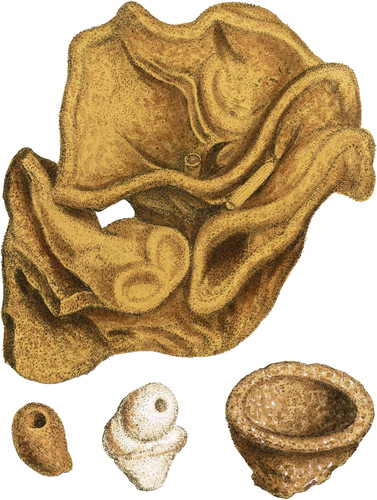 Enlarge
Enlarge
British Mineralogy
Sponge-form Carbonate of Lime. Sponge Rock
Since rocks or formations maybe particularised, and the modern laudable plan of investigating claims definite characters when they present themselves to identify them by, I thought, before I finished this work, it was an obligation on my part to hint something towards it; especially the upper series, which are most numerous, and will necessarily want comparative analogues. With this view, the present Sponge Rock is remarkable, distinctly to be recognised, and instructive. The name, I presume, will answer the purpose as well as Coral Rock or Formation, I do not know that it has been mentioned by any author under any title. I will therefore observe what are its characteristics; not knowing accurately whether its extent or quantity will allow of its being considered a distinct formation, or whether it is only a part of the Coral Rock; which may, however, by such attention, be better remembered. The place where these petrified sponges are found, is, from their appearance, called a gravel-pit, and has been opened a long time to supply the roads in its vicinity. It is altogether a mass of much variety ; the sponges, some resembling the Sea-fig Sponge, (Sol. and Ellis, tab. 59. 4.) being conspicuous and abundant, occur either in large irregular masses, small or just expanding specimens, or very large aggregated or more varied shapes. The upper figure is of the latter description, they grow together somewhat paras ideally; the smaller irregularly conjoined with the larger, besides admitting of some variety, as undulating, &c. Fragments of Echini, and other marine productions, are often attached to them. The lower figures are a series from the younger nearly globose small ones, to the longer and more perfectly cup-shaped ones. It in some measure resembles the Spongia infundibuliformis. I will, for distinction’s sake, call it Spongia pezizoides. I had given a hasty description published in Linn. Trans, vol. x. p. 405.
The pit has immense quantities of these, the greater part broken; and also of Echini spines, masses of mixed stones, and I found a curious piece of the septa of a large Nautilus, resembling N. centralis, Min. Conch, tab. 1, but I think another species, in which the siphuncle is central. The cast of the chambers is a mere mixture of fine gravel, and bits of shells, cemented by a dark ochraceous substance. There are also some very perfectly preserved Terebratulæ, some smooth, others undulating and notched, showing the cartilaginous appendages within, well preserved. Many other remarkable small corals, and even flustræ, accompany these. Somewhat resembling the Crag Rock as they are called in Suffolk, as tab. 481, but does not afford the characteristic Murex contrarius, Min. Conch. 23, or M. striatus Min. Conch. 22.

